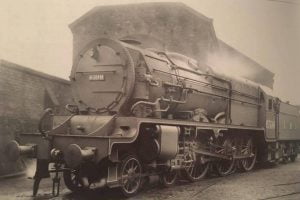Moving onto a lost London Midland and Scottish Railway designed locomotive, this week’s Lost Class article looks No.6399 Fury, a one-off experimental engine.
LMS No.6399 “Fury”
The designing and building of 6399 “Fury” was the result of a collaboration between the LMS and The Superheater Company in 1929.
Many railway companies around the world had toyed with the idea of taking the basic steam locomotive and push its design to maximum, trying to achieve high efficiencies.
With 6399, the aim was to use a high-pressure boiler to achieve a reduction in both water and coal. When completed, the engine was classed as an ‘Ultra-High Pressure, Semi-Compound Steam Locomotive’.
Design and Construction
From this partnership, the LMS provided the ‘Bottom-End’ for the experimental engine. The chassis followed closely to Fowler-designed Royal Scot class. Due to the locomotive’s ‘semi-compound’ nature, the cylinders’ diameters were of different sizes, both outside low-pressure cylinders had an 18in diameter and the inside high-pressure cylinder had an 11.5in diameter.
The Superheater Company designed the complex one-off boiler, which consisted of three stages of steam production.
- Stage 1 “Ultra-High-Pressure Circuit” – This was a closed system which used distilled water. Operating between 1400 to 1800psi, the water would transfer the heat produced by the firebox to Stage 2’s High-Pressure Circuit”.
- Stage 2 “High-Pressure Circuit” – The steam generated here was held at 900 psi and used to power the cylinders. Distilled water would also be spread around the boiler.
- Stage 3 “Orthodox Circuit” – At this stage, steam was produced in the conventional practice. Heat from the firebox formed steam by heating water held in tubes. The pressure was 250 psi.

The North British Locomotive Company was contracted to build the boiler, sourcing parts from Sheffield based John Brown & Company and Germany, alongside parts built in-house. Late 1929 saw the engine completed, shortly afterwards receiving its LMS Number and Name No.6399 “Fury”.
Performance in Service
Initially, short-distance test trains were carried out before running a test train between Glasgow to Carstairs on February 10th 1930. While approaching Carstairs at the end of the test, 6399 suffered a major failure in which one of the ultra-high-pressure tubes burst. Sadly, this resulted in the death of Lewis Schofield of The Superheater Company, who was riding on the footplate at the time. On examination, no reason for the failure was discovered (Following a further incident with a similar French engine, the strongest theory is poor water circulation in the tube caused them to burst).
Decline and Withdrawal
Once repaired, the locomotive moved to Derby for further tests. The outcome concluded the design had many weaknesses and the engine ended up being withdrawn and rebuilt into a Stanier Modified Royal Scot. At the time, Stanier would have been busy working on various projects, such as his own experimental ‘Turbomotive’. Although not suffering another failure, when pros and cons were considered in 1935, the engine lacked significant reduction in coal and water consumption. This meant the locomotive failed to meet its purpose, and with an expensive to build and maintain boiler, there was no reason to keep the engine. 6399 “Fury” never was allocated to a revenue earning service in its short six-year life.
Preservation
Although with further development and testing 6399 “Fury” could possibly lead the way in highly efficient engines, 21st century Heritage and Mainline use doesn’t have a place for a replica or rebuild of the engine. Route availability would be 9, restricting the locomotives, let alone carrying out further design and building work, which would only make the project more expensive.
We hope you enjoyed this week’s unusual Lost Class. RailAdvent hopes to be back next Wednesday to bring you another Lost Class article.
- Visit the RailAdvent news homepage
For the latest railway news - Visit the RailAdvent Shop
For railway related goodies! - Visit LocoStop – Our New Social Network
Come and share your photo’s and video’s, join the discussion.
Find out what others are sharing
Was a LMS “Countess” class locomotive, a larger versions of the Duchess/Coronation class 46220 series ever built?